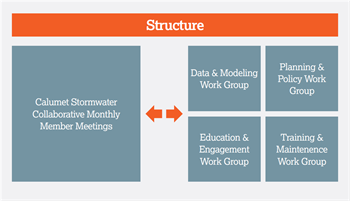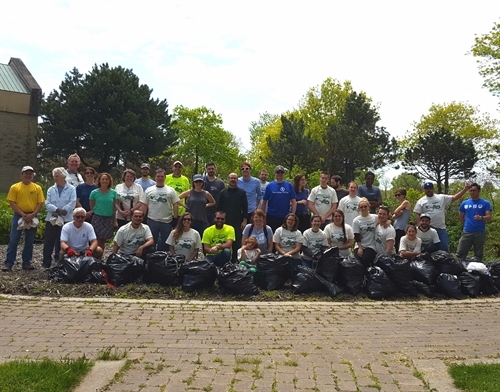
MPC
The Calumet Stormwater Collaborative holds meetings that enable stakesholders to align efforts, identify synergies, partner on initiatives, and share best practices.
Tweet this
This article was originally published in Volume 6 / Issue 1 of the Spring 2018 Stormwater Management Magazine—an official publication of the WEF Stormwater Institute.
The Calumet Stormwater Collaborative (CSC) provides an effective model for establishing partnerships to holistically address complex urban stormwater challenges. Formed and facilitated by the Metropolitan Planning Council (MPC), a Chicagoland urban planning and policy change organization, Danielle Gallet from the MPC explains the lessons learned from the CSC’s experience in working with diverse stakeholders across jurisdictions to address these challenges.
In the Great Lakes region, the United States (US) city of Chicago, Illinois, floods from very small, frequent storm events, which cause considerable damage to property, infrastructure, and quality of life. Unlike anticipated, dramatic sea level rise that threatens coastal areas, Chicago already feels the effects of climate change, such as increasingly frequent and intense rain events. However, current flood risk is poorly understood, and communities in the region are not prepared for storms with higher volume precipitation.
In 2014, the MPC formed the Calumet Stormwater Collaborative (CSC) to convene stakeholders in the Calumet region of south Chicago and its many suburbs.
Addressing the challenges of existing and future flooding requires a new level of coordination across government agencies, utilities, non-profit organizations, research institutions, and residents. A public policy, non-profit entity in Chicago, the Metropolitan Planning Council (MPC), played a major role in organizing diverse stakeholders to work together to solve flooding issues.
In 2014, the MPC formed the Calumet Stormwater Collaborative (CSC) to convene stakeholders in the Calumet region of south Chicago and its many suburbs. The CSC provides a forum to align efforts, identify synergies, partner on initiatives, and share best practices. To date, CSC members have come together to bring planning assistance to municipalities, develop green infrastructure design templates, update watershed plans for the US Environmental Protection Agency (EPA) Section 319 approval, produce a regional mapping viewer of existing data and modeling, curate an online repository of stormwater best management practices, and conduct a market analysis to evaluate workforce opportunities in green infrastructure installation and maintenance.
With more than 25 member organizations, and 40+ attendees to each monthly meeting, the Calumet Stormater Collaborative provides a case study for other regions—a model for how to establish, engage, and retain intergovernmental and cross-sector partnerships to address complex urban problems.
Additionally, the CSC provides a model for how to establish, engage, and retain intergovernmental and cross-sector partnerships to address complex urban problems. Having been strongly established for more than three years, with more than 25 member organizations actively involved, and over 40 people regularly attending its monthly meetings, the lessons learned in how to bring multiple agencies and stakeholders together to work collaboratively provides a useful case study for other regions.
Addressing urban flooding
Coordination between governments is a fundamental challenge to managing stormwater in any geography, be it a watershed or manmade sewershed. Government units have different regulatory and political pressures with varying financial and technical capacities. Absent coordination, inconsistency in goals, processes, and investments will hamper success. Other non-government actors that also manage land or financing tools must be included in a coordinated effort since they are equally as much a piece of the puzzle.
The guiding principles of the Calumet Stormwater Collaborative are:
Mission Statement: The CSC builds intergovernmental and cross-sector partnerships to increase the effectiveness of stormwater management initiatives for the communities and ecosystems of the Calumet region through knowledge sharing, coordination, and deployment of interventions at appropriate scales.
Vision Statement: The CSC will be a model of coordinated deployment of knowledge, technology, and financial resources to minimize the negative impacts of precipitation and maximize the positive impacts to make the Calumet region a better place to live, work, and recreate.
Additionally the CSC established the following fundamental challenges it seeks to solve:
- Stormwater overwhelms current infrastructure
- Green infrastructure’s role in stormwater management is still taking shape
- Coordinated action between government units and other stakeholders controlling land, infrastructure, financing tools, and regulatory powers is necessary to solve systemic problems in systemic ways.
The CSC aims to foster awareness of the many ongoing stormwater management initiatives in the Calumet region, forge a shared understanding of terms, establish common goals, and identify opportunities to align existing initiatives (or develop new ones) toward those goals. Many agencies are working in the Calumet region, and the purpose of the CSC is to help further support and leverage their projects and activities for maximum beneficial impact, while not impeding or interfering with the good work already being done.
Lessons learned
Beyond the accomplishments of the CSC in reducing the negative impacts of flooding and water quality for local communities, the specific design, engagement, and retention of members has been a case study for MPC in learning how to develop successful stakeholder engagement that keeps individuals and various agencies consistently involved and productive.
The following important lessons that have been learned by the CSC along the way can be beneficial for others in considering how best to facilitate and engage a diverse group of stakeholders.
1. Go slow to go fast
It is important to not jump into a conversation about what a newly established group of diverse stakeholders will do together before first establishing why it’s important to join together. Take the time to establish similar interests from the outset, and build consensus on key issues to be solved. Have a fresh discussion on the problem that is motivating the potential collaboration, and leave behind pre-conceived notions. By not rushing the conversation, stakeholders have the opportunity to truly listen to one another, establish ground rules together, and set the tone for how they will work collaboratively together in the future.
2. Gather the right mix of stakeholders
If the agencies, communities, and individuals that have the power to enact change are not engaged and available to participate, no amount of good intentions will enable true, on-the-ground accomplishments. While sitting down one-on-one with invited stakeholders to understand their current work, concerns, and motivations before convening a group can take considerable time, it is invaluable to driving buy-in to the collaborative, cross-stakeholder initiative being formed. This rapport allows stakeholders to feel heard and more comfortable meeting with others to discuss how they can work together going forward.
3. Align mission, structure, and initiatives

CSC Structure
Make sure that the structure established for how the group will work together honors the mission and meets the needs of the initiatives. While a mission statement of the group should live on, the structure (group administration, meeting schedules, work groups, agenda setting, etc.) and actual work or initiatives of the group should be an iterative process that can be updated and adjusted as needed, based on how the group can most effectively work together, and on what issue. Keep flexible and be open to the needs and ideas of stakeholders for continuous improvement of the strategies that help maintain the working relationship.
4. Steward funding opportunities
Find funding opportunities that allow cross-agency and/or multiple jurisdictions to work together on an initiative. While the initial excitement of working together can keep momentum going for practical work achievements, locating joint funding opportunities will help ensure long-term engagement and accomplishment of group initiatives. Once the original excitement wears off, having dedicated funding to achieve jointly beneficial projects will help maintain momentum.
5. Have fun, create value
The power of fun and inspiration for keeping a group together can never be underestimated. People love to win and be recognized for the good work they are doing, so consider giving out awards for perfect attendance or Most Volunteered Participant (MVP). Plan social activities together: happy hours, ice skating outings, a joint river cleanup event, trivia games based on knowledge of the group’s shared work and expertise. A group that plays together stays together. Sharing recreational and social time builds trust and cohesion in addition to a collective knowledge base and language that can beneficially impact a region beyond the boundaries of the agencies and individual stakeholders themselves.

MPC
CSC members having fun during a Calumet River Day Clean-up Event.
MPC and the Center for Neighborhood Technology and the Chicago Metropolitan Agency for Planning—fellow CSC members—continue to feature the work of this collaborative effort through both engaged case study presentations and moderated discussions with audiences about how collaboration techniques are working (or not working) across the US to help address climate resiliency through the lens of urban flooding and stormwater management.
Conclusion
The challenges related to increasingly intense storm events, outdated infrastructure, and fragmented jurisdictions—humanmade boundaries that stormwater itself does not recognize—require a new level of coordination across agencies and municipalities. The good news is that agencies and municipalities are made up of individual people. So learning to partner across human-made boundaries to improve quality of life for our communities can start as simply as reaching out for a coffee chat. Reach out and start a conversation, find your common thread, establish a working relationship, and get started.
Author’s Note
Danielle Gallet is a water resource strategist, urban planner, and adjunct instructor. Her work involves implementing strategic, creative, and viable solutions that address issues related to water resource planning, management, financing, and infrastructure. She oversees the Metropolitan Planning Council’s Water Programs.